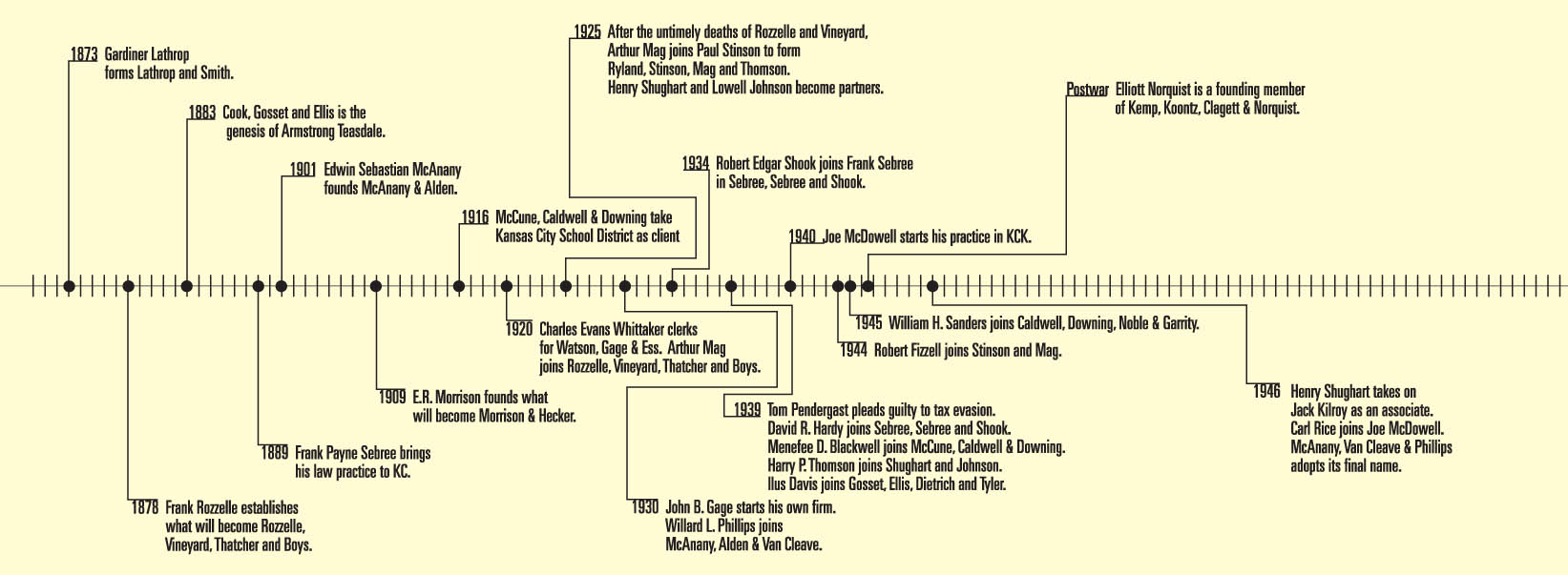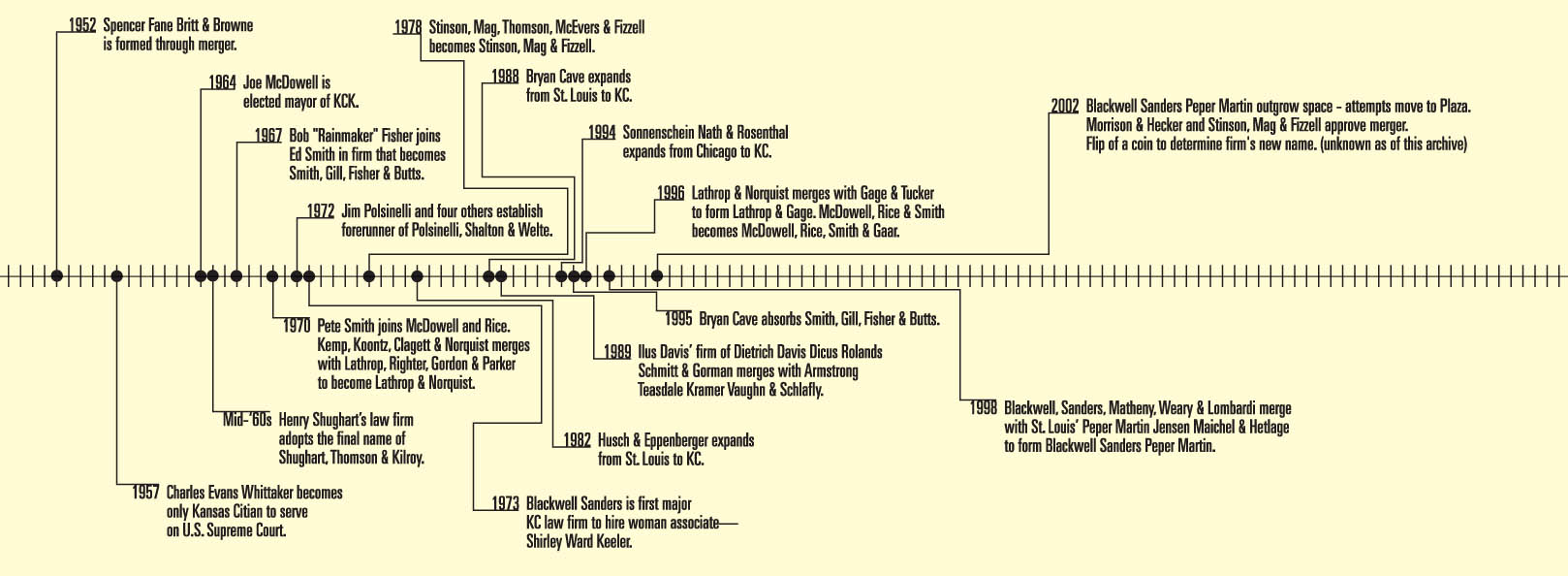|
Frank Payne Sebree was just a kid in the
1860s, so it surely made an impression on him when Quantrill’s Raiders
plundered his family’s farm in Howard County, Mo. Frank James, not
yet a legend but soon to be, was among those that robbed the Sebree farm
of chickens and eggs and supplies on that day early in the Civil War.
Sebree grew up, became a lawyer, and moved to Marshall, Mo., just one
county over from Howard. He had established his reputation, had even served
in the legislature, when Governor Crittenden appointed him as special
prosecutor for a special case. On the second day of July, 1883, in Gallatin,
Mo., Sebree took up the interests of the people in the matter of a Winston
train robbery and murder. The defendant was Frank James.
The story would be even better if Sebree had won a conviction that July,
but in three separate trials for robbery and murder, the law could never
lay its claim on James. Still, Sebree did all right for himself—six
years later he came to Kansas City and started a two-man practice that
over the next hundred years would become the international, 528-member
firm of Shook, Hardy & Bacon.
A walk through the past of some of Kansas City’s top law firms is
like a walk through history. From the Civil War to the current conflict,
the attorneys in our town have been a part of the benchmark litigation,
policy and politics that have shaped our lives.
Frank Sebree became one of the pioneers in that history when he started
his Kansas City practice in 1889. But before him there was Gardiner Lathrop
in 1873, founding father of Lathrop & Gage, and Frank Rozzelle in
1878, founding father of Stinson, Mag & Fizzell. Whether or not their
names remain on the letterhead of their firms today, they have made a
mark on our city that will never be erased.
According to partner John Dods, self-proclaimed unofficial historian of
Shook, Hardy & Bacon, Sebree served as chairman of the park board
during the development of Kansas City’s boulevard system and the
Liberty Memorial, both landmarks that continue to set our city apart from
others. Rozzelle served as a city counselor, as a police commissioner
and as personal attorney to William Rockhill Nelson. He created a trust
for Nelson for the purpose of buying art for a museum, and he in fact
bequeathed his own estate to help build that museum. Rozzelle Court at
the Nelson-Atkins Museum of Art is named in his honor.
Lathrop & Gage still represents Gardiner Lathrop’s first client—the
Burlington Northern Santa Fe Railroad (known then as the Atchison, Topeka
& Santa Fe). Other long-term relationships were developed around the
turn of the century as well. One of the first clients of McCune, Caldwell
& Downing—formed in 1916—was the Kansas City School District
(KCSD). The district remains a client of the firm, although it’s
the firm rather than the client that has changed names. Today, legal counsel
for the KCSD is Blackwell Sanders Peper Martin, descendent of McCune.
One of the names that has survived through time is that of Henry Shughart,
who along with Lowell Johnson joined the firm of Rosenberger and Reed
in the early 1920s. There is some question whether Reed was already dead
or whether the name was a cover meant to deflect anti-Semitism from Rosenberger.
Either way, Rosenberger died in 1926, and the two associates found themselves
partners in the firm of Shughart and Johnson.
Arthur Mag found himself in a similar situation at about the same time.
He joined the firm of Rozzelle, Vineyard, Thatcher and Boys in 1920, and
was still an associate in 1924 when both Rozzelle and Vineyard died. One
of the remaining partners retired shortly after and the other became terminally
ill. Despite his youth and relative inexperience, Mag convinced Stern
Brothers, Schutte Lumber and Wright Liquid Smoke Company to remain with
him. He soon joined forces with Paul Stinson and I.P. Ryland to form Ryland,
Stinson, Mag and Thomson in 1925.
Over the next 15 years, John B. Gage and Joe McDowell started their own
firms while Robert Edgar Shook joined Sebree in the firm that would become
Sebree, Sebree and Shook. Gage and McDowell would go on to become mayors
of Kansas City, Mo., and Kansas City, Kan., respectively. A bumper crop
of bright associates came on the scene in the late ‘30s with David
R. Hardy joining Sebree, Sebree and Shook; Menefee D. Blackwell and John
Oliver joining McCune, Caldwell and Downing; Harry P. Thomson joining
Shughart and Johnson; and Ilus Davis joining Gossett, Ellis, Dietrich
and Tyler.

Kansas City in the 1930s, of course, belonged to Tom Pendergast. Among
his many activities during the Depression, he was an expert at winning
contracts for federal relief projects; his Ready Mixed Concrete company
built nearly every Kansas City building made of poured concrete at that
time, including Municipal Auditorium and City Hall. His political machine
reached a peak in the 1936 election when his candidates received 60,000
votes cast by ghosts.
Many of Kansas City’s law firms claim to have a forefather who was
instrumental in bringing down the Pendergast machine, but so many attorneys
have served in public roles over the city’s history, at least some
of those claims must be true. Ed Shook, as chairman of the board of election
commissioners at that time, helped put a stop to voting irregularities.
Before and after Pendergast pled guilty to tax evasion on May 22, 1939,
John Gage, William Kemp and Paul Koontz—all ancestors of Lathrop
& Gage—worked for the cleanup of local government. John Gage
was elected as the “Reform Mayor” in 1940.
Then there was the war. Not the war to end all wars, but the one after
that. Partners put law-firm expansion on hold while associates and law-school
grads went off to fight in World War II. It was only toward the end of
the war that things began to get back to normal. In 1944 Robert Fizzell
joined Stinson and Mag in their firm. In 1945, William H. Sanders joined
Blackwell at Caldwell, Downing, Noble & Garrity. In 1946, Jack Kilroy
was invited to practice with Thomson in the Law Offices of Henry M. Shughart.
Elliott Norquist became a founding member of Kemp, Koontz, Clagett &
Norquist.
Still, by today’s standards, firms were small. According to Ed Matheny
in his history of Blackwell Sanders called A Long and Constant Courtship,
the firm—then known as Caldwell Downing—“had six lawyers
in 1945, Shughart Thomson had four, Shook Hardy had four, and Stinson
Mag was regarded as a ‘factory’ with 12.” Matheny became
Caldwell’s 10th attorney in July of 1949, following his graduation
from Harvard Law School. The firm had leased space for only 10 lawyers,
believing that to be the optimum number to serve its clients.
But, Matheny says, the firm’s litigation practice exploded during
the prosperous 1950s, and many other law firms saw their clientele grow
as well. Spencer Fane Britt & Browne was formed through merger, and
Ed Smith founded what would become Smith Gill Fisher & Butts. Blackwell
Sanders saw its work with the Kansas City School District heat up with
the case of Brown vs. Board of Education. And in 1958, David Hardy of
Shook, Hardy & Bacon won $200,000 for a policeman injured by a concrete
truck in the case of Moore v. Ready Mixed Concrete—the largest award
for a plaintiff ever in the state of Missouri. It was a double sweet justice
for a Shook lawyer to prevail against Pendergast’s old enterprise.
Hardy became the driving force behind Shook’s growth, according to
historian John Dods, with a case that came his way in 1962. John Oliver
of Blackwell Sanders had been representing the defendant in Ross v. Philip
Morris, a suit brought by a smoker with throat cancer in the U.S. District
Court in Kansas City. When Oliver was appointed to the bench in ‘62,
he had to relinquish the case. Because of the Moore verdict, David Hardy
looked like the next best option. All Philip Morris needed was a Missouri
lawyer to appear in a Missouri court just for this one case.
After two years of preparation, Hardy exonerated his client in a three-and-a-half
week trial, and Philip Morris knew it had found a new law firm. That single
case catapulted Shook, Hardy & Bacon to the forefront of product liability
defense.
The changing social environment of the early ‘60s began to impact
the legal profession. Ilus Davis, known for his deft handling of race
relations, became mayor of Kansas City in 1963. According to Promise and
Legacy—McAnany, Van Cleave & Phillips’ centennial history—that
same year the Wyandotte County Bar Association, in its conditions of membership,
agreed to strike the word “white” before “male.” It
would be three years later before the word “male” was stricken
from the constitution altogether.
Blackwell Sanders found itself on the cutting edge of social policy in
the 1970s in several ways. In 1973, it became the first major law firm
in the city to hire a woman associate—Shirley Ward Keeler—and
with her promotion in 1978, it became the first to include a woman partner.
Secondly, it and the Kansas City, Mo., School District became deeply embroiled
in the court-ordered desegregation of the district. McAnany, Van Cleave
& Phillips advised the Kansas City, Kan., School District in segregation
matters on the other side of the state line.
The 1970s, ‘80s and ‘90s became a time of both expansion and
merger for local law firms. Kemp, Koontz, Claggett & Norquist, for
example, merged in 1970 with Lathrop, Righter, Gordon & Parker to
form what eventually would become Lathrop & Norquist. Husch &
Eppenberger and Bryan Cave expanded into the Kansas City market from St.
Louis and Sonnenschein Nath & Rosenthal moved in from Chicago.
The ‘90s in particular saw the joining of firms looking for ways
to cut overhead and combine complementary practices. Bryan Cave absorbed
Smith, Gill, Fisher & Butts in 1995; Lathrop & Norquist merged
with Gage & Tucker to form Lathrop & Gage in 1996; and Blackwell,
Sanders, Matheny, Weary & Lombardi combined with St. Louis’ Peper
Martin Jensen Maichel & Hetlage to form the current Blackwell Sanders
Peper Martin in 1998.
None of Blackwell Sanders’ founders has survived the firm’s
nine name changes. Frank Payne Sebree also fell from his firm’s letterhead
somewhere along the way even though Samuel Sebree II—a great-grandson
of Frank—practices in Shook Hardy’s London office yet today.
Polsinelli, Shalton & Welte retains the names of its original and
still-active founders, however, and Gardiner Lathrop has held tight for
130 years.
Now Morrison & Hecker and Stinson, Mag & Fizzell have said, “I
do,” to a marriage of titans. Their planned merger will create the
second-largest law firm in Kansas City with 340 attorneys. It’s hard
to believe that the names that remain on the letterhead and the ones that
disappear will be determined by the flip of a coin, but apparently it’s
so.
Regardless of whose names appear on the office door, however, there are
partners and associates all over Kansas City today who are making a mark
on our history that will never be erased.

Return
to Table of Contents
|

